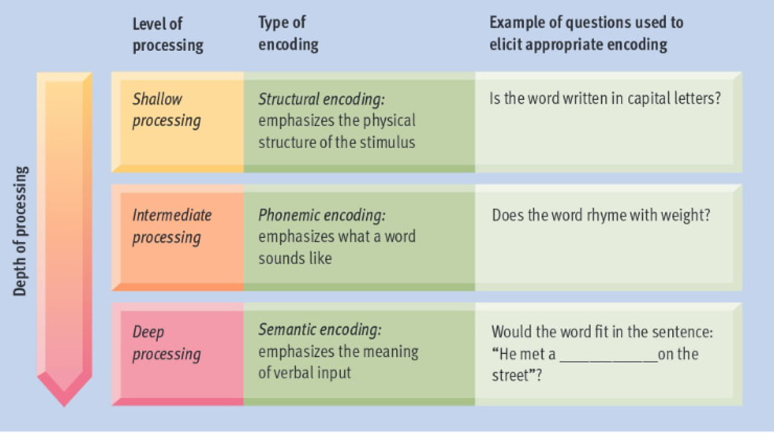PSYCH 200 final
1/28
There's no tags or description
Looks like no tags are added yet.
Name | Mastery | Learn | Test | Matching | Spaced |
|---|
No study sessions yet.
29 Terms
Atkinson and shiffrin model of memory storage

Sensory memory
Holds information long enough to be processed for basic physical characteristics
Large capacity
Very brief retention of images
.3 sec for visual
2 sec for auditory
Short term memory
also called working memory
Stores sounds images and words
stores for about 20-30 seconds then is either commited to longterm memory or is lost
On avg people can hold 7±2 items in their working memory
Free recall
Subjects are free to recall a list of items in any order
Serial recall
Subjects are to recall the list of items in their original order of presentation
Free vs serial recall
In serial recall, subjects have good memory for beginning of list, performance is poorer toward end of the list
In free recall, subjects have good memory for both the beginning and the end of the list
Serial position effect
People have a good memory for items at the beginning of a list (reflects long term memory)
People also have a good memory for items at the end of a list (reflects working memory)

Long term memory
Unlimited capacity store that an hold information over lengthy periods of time
Retrieval failure viewpoint
Assumes that information is never lost from LTM, if you cannot remember something, that thing is lost in memory, not lost from it
Failing to find something does not mean that the thing has vanished
Decay viewpoint
Assumes that information in LTM may decay and hence is lost from it over time
Recall vs recognition test
Recall: Requires participants to reproduce information on their own without any cues
Recognition: Requires participants to select previously learned information from an array of options
Effective encoding
Chunking
Elaboration
Levels of processing

Depth of processing theory
proposes that deeper levels of processing result in longer-lasting memory codes
Assumption is that levels of processing increase from physical structure to phonemic structure to semantic structure
Chunking
Arranging information into meaningful chunks
Good memory involves organization
Memory consolidation
Neural process by which encoded information is stored in memory
Process in which synaptic connection is strengthened
War of ghosts experiment
People tend to shorten the story, terminology became more modern
Specific terminology was replaced by more general expression
Proper names disappeared and direct speech was dropped
Readers were better at remembering what they added themselves to the story
Hypermnesia
Readers can produce verbatim recall what they added to the story
Re consolidation
Testing does more than assessing the outcomes of learning
Testing improves learning
Self testing produces the best learning outcomes
Semantic memory
Object knowledge learned over many interactionsE
Episodic memory
Memory for specific events that you have experienced
Semantic network

Schemas
Organized cluster of knowledge about a particular object or event abstracted from previous experience with the object or event
People are more likely to remember things that are consistent with their schemas than things that are not
Retrograde amnesia
Poor memory for events that occurred before brain injury
Anterograde amnesia
Poor memory for events occurring after brain injury
Patient K.C.
Suffered severe frontal lobe damage in a motorcycle accident.
Complete loss of episodic memory:
Profound anterograde amnesia (cannot form new episodic memories after the injury).
Profound retrograde amnesia (cannot recall past episodic memories before the injury).
Intact semantic memory:
Retains factual knowledge (e.g., knows what a funeral is and that it’s sad).
Cannot recall personal events (e.g., his brother’s death) but can infer emotions based on semantic knowledge.
Demonstrates the dissociation between episodic and semantic memory in the brain
Patient HM
Cause of surgery: Severe epilepsy → bilateral removal of hippocampus + parts of temporal lobes.
Memory impairments:
Severe anterograde amnesia: Could not form new explicit long-term memories (e.g., couldn’t remember meeting researchers).
Intact retrograde memory: Could recall childhood events, facts (e.g., baseball rules), and pre-surgery memories.
Working memory intact: Could hold conversations but forgot them within minutes (e.g., repeated topics unknowingly).
Other preserved abilities:
Normal IQ, language comprehension, and vocabulary.
Could learn implicit/procedural memories (e.g., mirror-tracing task).
Key findings:
Hippocampus is critical for encoding new explicit memories but not for storing old ones or implicit memory.
His case showed the dissociation between short-term (working) and long-term memory.
Famous quote: “Every day is alone in itself.”
Perceptual priming
exposure to a stimulus will facilitate a future